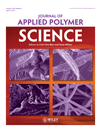Thermoresponsive shape memory characteristics of polyurethane electrospun web
Abstract
Electrospun web (ESW) was manufactured and its performance was evaluated to investigate its applicability as an intelligent clothing material using shape memory polymers. Mixtures of various compositions were applied to make the shape memory polyurethane (SMPU) films and the polyurethane with the best shape memory performance was then selected to make the ESWs. The structural and thermal properties, as well as the shape memory behavior were evaluated. The air permeability, the water vapor transmission, and the water resistance were measured. The ESW having a high orientation due to an elongation in the process of the electrospinning showed a higher melting point than the film and its shape recovery was improved. The ESW showed a good moisture and air permeability due to the fact that its structural characteristics incorporate countless nano-sized pores. Because of this, the ESW maintained in its expanded state below the transition temperature showed improved moisture and air permeabilities. Therefore, it can be concluded that the SMPU web proved to have potential for intelligent clothing material. © 2010 Wiley Periodicals, Inc. J Appl Polym Sci, 2011




